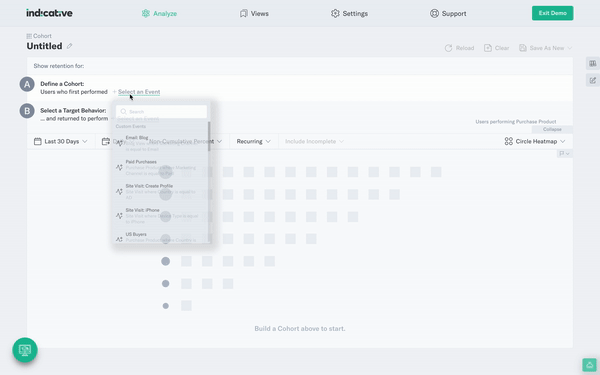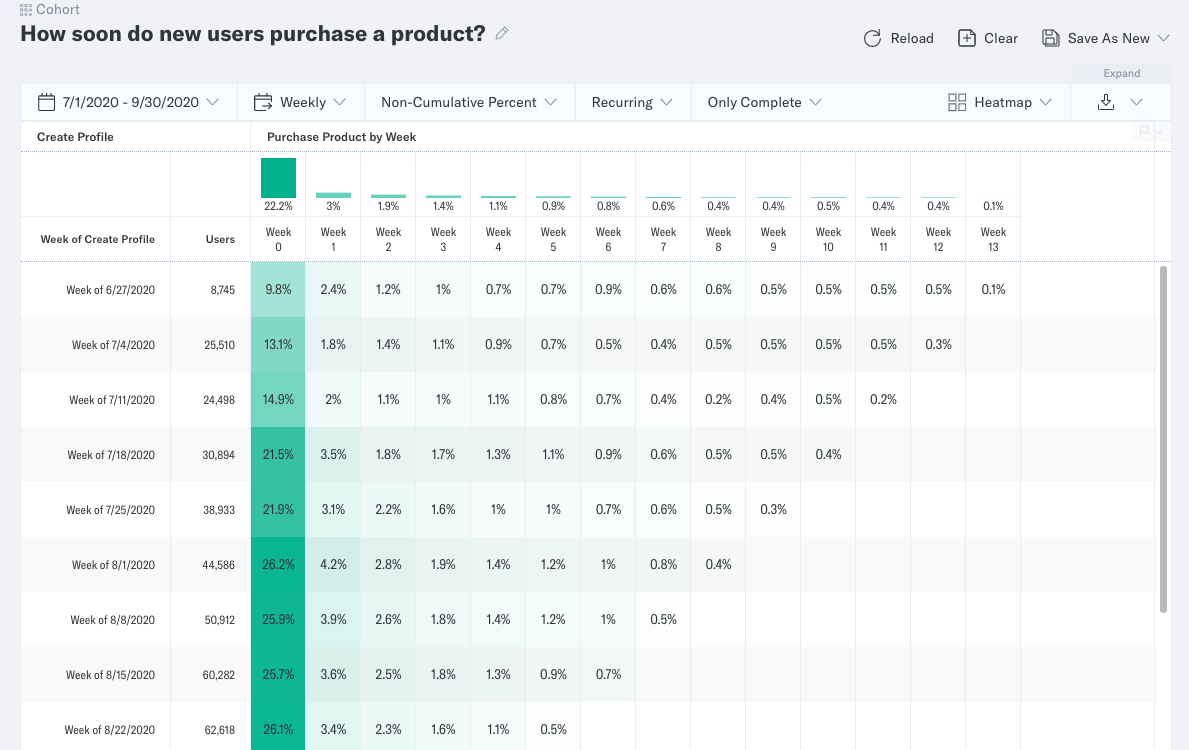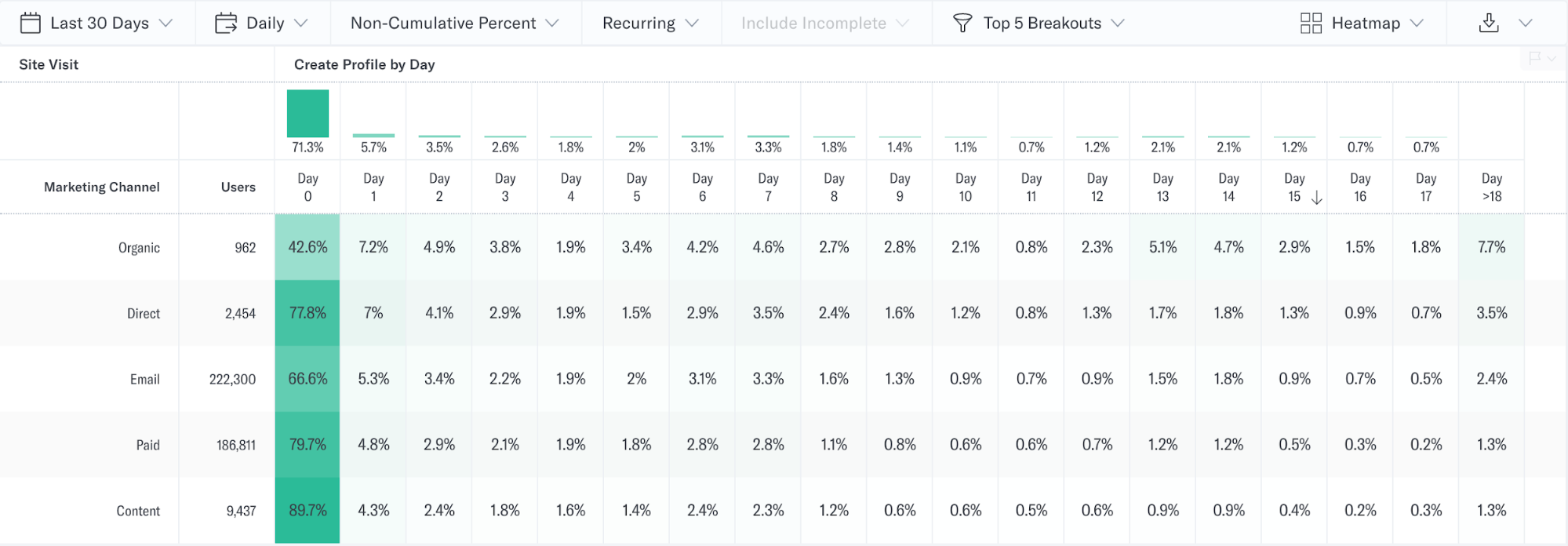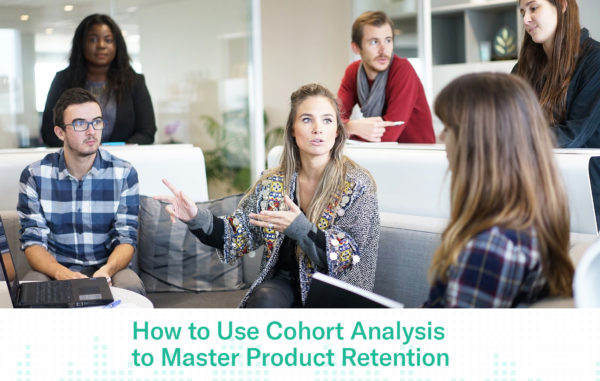Product Retention and the Status Quo
We get it – customer retention is hard work. The average worldwide retention rate in mobile apps from 2012 – 2019 was less than 35%. This means product teams have to work hard to improve onboarding and engagement to retain customers. Lenny Rachitsky (Growth PM, Airbnb) and Casey Winters (CPO, Eventbrite) launched a comprehensive benchmark report on retention recently. The report agrees that cohort retention metrics are essential to sustainable economics and growth for any company type and size.
However, improving customer retention is an uphill task, since retaining users in your product is rarely a singular team’s effort. Product marketing, customer success, and product teams need to work together to provide value for your customers to keep them returning to your product. Consistent effort in retaining customers keeps customer acquisition costs low and increases lifetime value.
Understanding the usage patterns of your existing customer base is critical. Analyzing your customer’s journey can unlock key areas of friction and provide opportunities to improve your application or product. Product teams split customer segments either based on their onboarding or actions and then break them into groups or ‘cohorts’ for a given time period. Splitting these cohorts by period and observing changes in behavior over similar periods in the customer lifecycle is a great way to analyze what events or triggers do customers respond to, and improve your product accordingly.
This process is known as cohort retention analysis.
Cohort Analysis: Asking the Right Questions
Cohort analysis helps product teams break customer segments by initial onboarding or by user flow. As a product manager, this would help you understand how customers adopt and use your product to achieve their own goals, for which they purchased this product. Product design and engineering teams may have a distinct workflow in mind while creating the product. Cohort analysis helps these teams give themselves a reality check. It enables them to understand how customers go through this workflow and ask what stops them from making their decisions over a given time period.
Let us walk through a simple example: You are building an e-commerce app. You ask yourself the question:
Does saving credit cards on file lead to more sales?
We could evaluate the acquisition cohorts of customers who were onboarded in the past three months. We then split these cohorts by customers having a saved card on file versus those who did not. Once we split these cohorts, we can analyze their subsequent actions to purchase products. If saving cards on file leads to quicker purchase decisions, then it might be worth nudging customers to auto-save cards in the ordering process. On the other hand, if they delay saving the card details until later in the buying process, and spend more time creating a bigger cart volume across multiple shopping sessions, then it might be worthwhile postponing this action, so customers are more comfortable buying a larger order volume. This split analysis could help you check if customers in these behavioral cohorts end up spending more in their e-commerce flow.
One thing to note: we are simplifying all the other variables at play during an e-commerce transaction. We do not know in this scenario if the customer came to the app through a discounted promotion or if their spending patterns are only on paydays during a month. Comparing these two cohorts should help you understand how we can improve our product to influence buying behavior.
Cohort Analysis in Action
In the above example, we talked about how analyzing two customer cohorts over similar time periods can help us understand behavioral patterns. Let us now look at how these cohorts are broken down and visualized.
For example, we want to know the answer to the following question:
How soon do new users purchase our products?
We first find acquisition cohorts of customers who created a profile in the last three months and their date of purchase. This investigation path could help us understand if launching marketing campaigns to nudge users to create profiles could make them buy faster.

So we start defining our acquisition cohort in question by choosing a group of users based on their first step in the workflow – in this case, ‘Create Profile.’
Then we select this cohort’s target behavior, which is the end state of their actions in this workflow – in this case, ‘Purchase Product.’
Like in the previous example of saved credit cards, there might be several variables in the buying decision. You can define all those behavioral nuances in this cohort to answer your question.

This visualization shows that the first week is crucial to enable your new customers to purchase a product. Forming a feedback loop right after the first purchase could lead to repeat purchases and more revenue. You can further refine your process by carving out smaller segments of customers in a particular week, and find out from where do they arrive in the app:
- Did they click on a social media ad?
- Did they respond to your welcome email sequence?
- Did a particular notification on their mobile app appeal to them? OR
- Did a particular app update lead to a buggy user experience?
The nuances mentioned above can help us understand the paths your customers take to complete their first purchase. This will help your team to improve their marketing campaigns and expedite buying decisions.
How to Use Cohort Analysis for Customer Retention
Cohort analysis helps your product teams ask specific questions to understand customer behavior in buying decisions. It is no surprise that your investigation’s quality depends on the depth of the questions you ask your data. Let us understand the primary scenarios of how you could improve cohort retention:
Cost of New Acquisition Channels
If your team is exploring new acquisition channels, then cohorts can help your teams optimize acquisition costs and focus on profitable channels.
For example, the behavioral cohort below shows us purchases made by users after subscribing to the product. It helps us understand direct channels like push notifications might be the biggest driver of the buying decision for your customers in the first week than other channels like email or referral marketing. So a concentrated effort in refining our notification approach could nudge our customers further into their buying decisions.

Product Update Performance
If your team launches frequent product updates, launch cohorts can help you probe your churn rate. There could be app sections where your customers experience poor performance, which your team can fix before it is too late.
For example, Snapchat released a massive redesign of their app in 2018 and faced severe backlash immediately after launch, with thousands of users protesting the change in the app experience. Launch cohorts can help you examine customer behavior before and after the update to drill down into massive pattern changes and fix these experience issues quickly.
Increase Customer Lifetime Value
Analyzing behavioral cohorts of your most engaged customers will help you understand their usage patterns over time. You could then use the lessons learned to create behavioral nudges in new customers to help them make quicker buying decisions. This will increase lifetime value for your product and support your product growth over time.
For example, Pinterest keeps a close watch on its cohort of ‘core Pinners’ or power users of Pinterest, who have visited 14 or more times in a 28-day period. It also monitors behavioral cohorts of users with a lesser proportion of usage to identify areas where these users typically drop off. Monitoring these cohorts helps Pinterest identify how to best communicate the core value Pinterest provides in the quickest way to the newest of users, thus increasing customer lifetime value.
In this manner, customer data cohorts could reveal surprising insights with minimal effort required to fix them. Such steps lead to your organization’s sustainable revenue growth since engaged customers are much more likely to purchase from you than your passive customers.
Summary: Cohort Analysis is a Powerful Tool
Cohort analysis is no silver bullet to give your product superpowers. If you ask more in-depth questions of your data, cohort analysis dissects that data to provide you pertinent answers.
Once you have the right set of questions, product analytics platforms like Indicative provide robust capabilities to create your cohorts. You can use several aspects of your customer profile like open email events, blog visits, or even custom events to tweak your data cohorts.
Are you interested in using product analytics to improve cohort retention and ask deeper questions about your data? We at Indicative provide powerful cohort analysis capabilities by connecting directly to your data.
Try our product demo today to find out how!
Contributor Statement

Renga is a product manager and digital experience leader. He previously built a 25-member strong product management practice at Deloitte Digital in India. He writes candidly on product, design, and technology on www.rengawrites.com.



